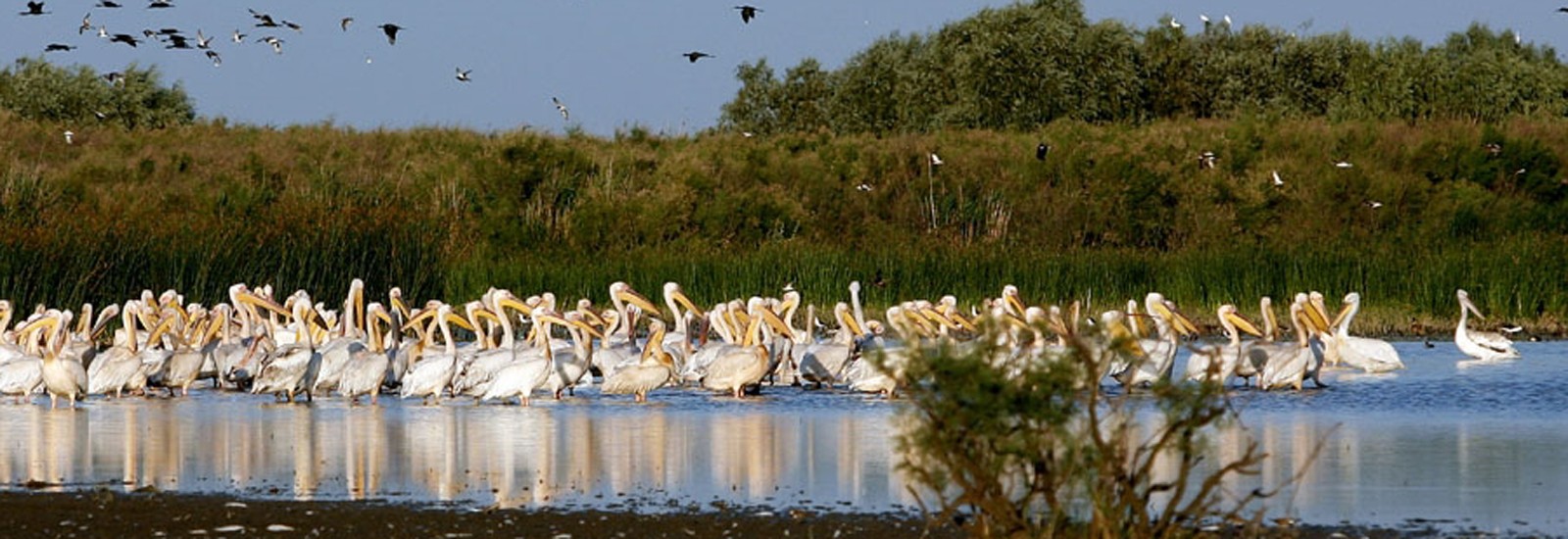Adventure in Danube Delta.
Postat 20-02-2021
The first day of our adventure begins at Tulcea, the city-capital of the Delta. The beautiful hotel placed on the shore of the Danube will welcome you with rooms orientated to the Danube and with the best conditions and food in town. For the evening, you can take dinner, on the Danube cliff on the fish restaurant of one of the Romanian Olympic champions at caiac-canoe.
First day. Tulcea.

The first day of our adventure begins at Tulcea, the city-capital of the Delta. The beautiful hotel placed on the shore of the Danube will welcome you with rooms orientated to the Danube and with the best conditions and food in town. For the evening, you can take dinner, on the Danube cliff on the fish restaurant of one of the Romanian Olympic champions at caiac-canoe. Here you can eat shark, turbot, perch, and catfish in many delicious combinations. After dinner, you can take a walk on the Danube Cliff and then savor a glass of wine on the hotel terrace looking at the Danube.
The next day will go to the floating hotel, to board. We, will, be welcomed by the personal will take our rooms, and will start the cruise. First off all will go to Sulina, the city placed to the shore of the Danube and of the Black Sea at the same time being the place where the Danube flows into the sea. The road until there will take about 7 hours, but the times fly when you are in pleasant company. We met along the way big boats coming from the Black Sea and going to Galati the big industrial harbor to load steel products, or navigating to the river to Vienna. The sun is in the sky looking to us and to meet it is enough to go up on the superior deck of the ship to lay down on the lounge chair to stay in the sun. Reading a book, drinking something fresh and cold you will be invited to the dining room to eat lunch.
Going inside we observed on the table a deliciously tasty meal. Fresh borsh made by the boat chef from fresh fish from the Danube, the second plate also fish and the desert, cakes made in the area by the Romanians, obviously not from fish. When the sun starts its way to the other side of the planet, we arriving in Sulina.
We dock the ship and get down to take a few steps on solid land after so many hours on the water. The port is small and nice and famous for us because here was filmed a series of movies for children and teenagers in the `70-s very popular for my generations. On our way to the Lighthouse, we look at the big boats docked. One of them is huge maritime ships which stop here for the customs formalities, another one is the passenger's ship which came every day from Tulcea transporting people and goods to be sold into the shops and markets from here. It is a moving specific to the ports all over the world and for us, which are coming from a longer distance, from mountain or field, where this life is unknown everything is very interesting.
The first stop is to the Lighthouse, and then, after the visit, we take a minibus and are going 2 km to the beach of the Black Sea. Is a small beach, with very fine sand, low waters, and a gentle sun. Is here at this corner of the world so much peace and silence that you are feeling like at the beginning of the world. The people are decent and don`t make noise, even the children are behaving like in a sanctuary, because this place, on a side of Romania and at the mouth of the Danube pushes you to respect. Respect for one of the largest rivers in Europe, respect for all the way that it makes from Germany until here, and respect for all the history which this water saw since the beginning of creation. Silence, gentle sun, and atmosphere of a new beginning. In a word, Heaven.
A little bit to the north, we can see the new Lighthouse and near it is the mouth of the Danube which came to its meeting with the sea.
We enter with our feet in the water to feel it, some of us undress and swim and for one hour we are relaxing and feeling good. We are turning back to Sulina and to our ship for the dinner. On the way back, because we still have time until the dinner and the group doesn't want to come back so quickly, we are entering to visit the Cathedral St Alexander and Nicholas.
Around 2000 we are back to the floating hotel and ready for dinner. Is night almost so, the gold of the wine flows into glasses, their clinging is heard together with wishes for health and luck, ( sanatate si noroc ) traditional in Romania for “cheers” The wine is an Aligote from Sarica-Niculitel vineyard, one of the well-known vineyards in Romania.
The meal prepared by perch tonight is waiting on the table together with a lot of other Romanian delicacies. In fact, along the trip, we served among others, the next food dishes: fish bors, fried fish (served with garlic and garlic sauce), boiled crayfish, frog legs,, sausages, fish roe, fish meat, fried carp, and carp on the cabbage, and in the dessert the goody dobrogeana pie made with cheese. Also fruits, cheese, olives, bread and butter, fried eggs, ham, and eggs
After dinner, we are relaxing on the terrace of the floating hotel drinking a beer or a wine, or a whisky depending on everyone's choice. Then, little by little the sun will go to sleep and will get down to our cabins for a good night's sleep after a beautiful and full day…good night!



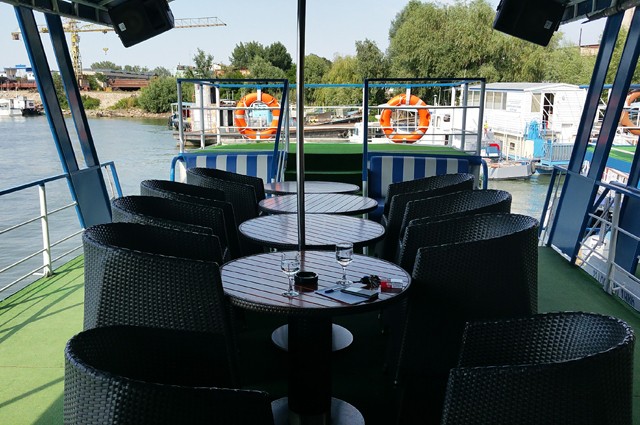

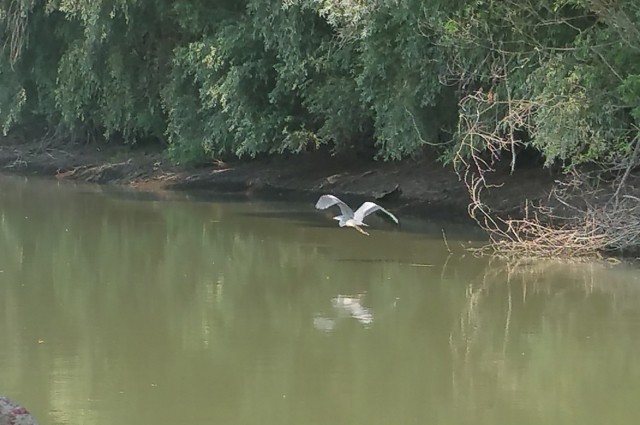
Second Day. Inside of the Delta.
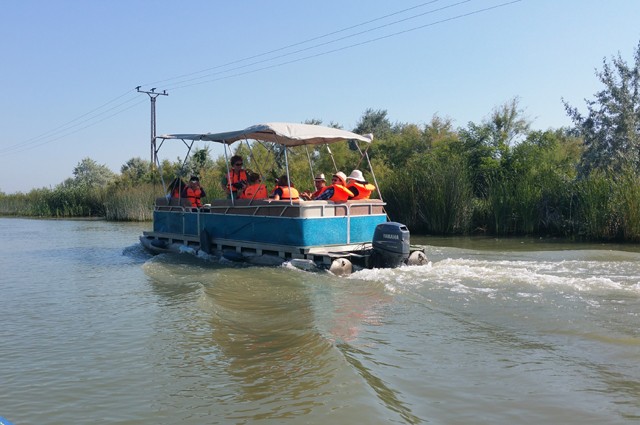
The next day we wake up in our cabins after a very good sleep and we are ready for a new glorious day. In fact the real trip it starts today because will enter the channels of the Delta using the small boats attached by the floating hotel. Motorboats. Will eat breakfast and then putting on us the life vests we are embarking on the boats. Here the rule say that the ladies and the children are traveling by catamaran ( is a multi-hulled watercraft featuring two parallel hulls of equal size. It is a geometry-stabilized craft, deriving its stability from its wide beam, rather than from a ballasted keel as with a monohull sailboat. The catamaran is from the Tamil word "Kattumaram" which means logs tied together.) and the man on the fishing boat.
We go and will meet at our floating hotel, on the Madgearu channel. Until that moment will go to Letea Forrest, one of the most amazing reserves from Romania and I think even Europe. One of the hidden treasures of the continent lays here in Danube Delta. But let`s not anticipate. The way until there will be on the water. We are passing through the real roads of the reed, passages through the reed which is elevating on the board's sides of the water channel. To the east is Port of Chilia where it was a work colony for the political prisoners from communism and which inspired a very popular song in Romania which is called “La Chilia`n port” ( In the Port of Chilia)
We see yellow water lilies and we enjoy the sun and the brize, talking about things of life for 2 hours. We go in tandem with the boat of ladies and we salute them from time to time until we arrive at Letea Village ready to visit the Letea Forrest. We dock to the small wharf of the village and are taking a few steps to the ground until the plate indicates that the village starts there. At that point, it was waiting for us a wagon drawn by donkeys to transport us into the forest. The wagon was arranged with small benches to be able to seat as comfortable as possible. It was droved by a young boy and his mom. Going to the village streets, full of dust, unpaved, looking to the old houses built in the local style, from clay and covered with reed, painted in blue the color of the Danube feels like a turn back in time. A village isolated by everybody in the middle of the water living hereafter the same rules of centuries. Suddenly we stop for “hydration” as said our captain. Meaning stop for toilet and a cold beer or Pepsi/Coke. After 20 minutes we continue the trip to the famous forest. It was surrounded by a net wall. We stopped in front of the gates and the boy jumped forward to open it. We enter, both wagons and he closed it back. The trip continued through the lush vegetation of white poplar, black poplar, elm tree, English oak, silver lime, narrow-leafed ash, and common alder. Along with those above, it is completed by a rich scale of sub-shrub species.
We stopped the wagons into the forest and from there we continued walking. Very weird it was that the soil was made of sand. I asked and the answer was that here in this region was entered the sea waters. That is why we have sent. We came out from the forest to a large region with some bushes from place to place and groups of trees where the wild horses which are living in here, the last horses from Europe, are used to come. In the same area, a little bit forward will find one of the rare things from this place, an old oak tree, which was here since 500 years ago. The thickness of its trunk was like 6 peoples taking hands around it. On the way back to the wagons we study it the subtropical plants which are growing here and we were amazed by the unicity of these places. The way back was very interesting and we get in our boats and continue another hour to the floating hotel which was waiting for us on the Madgearu channel.
Arriving at the boat we go straight to refresh ourselves after such a long journey on water and then to lunch. In the meantime, the floating hotels were sailing to Mila23-rd fisherman village famous in Romania because here was born and raised our Olympic champion at caiac canoe Ivan Patzaichin. Also is the largest community in the area. We stop after lunch on the other side of the island and was cross the Danube to visit it. The touristic activity here is very intense because many houses ere transformed into guesthouses ready to receive tourists. The end of this visit was at the main shop from the island to eat ice cream or drink a cold beer as everybody wish. After this back on the boat and then going to the floating hotel. From here we continue in the march to the place where will stop for the night and from there will go into an evening visit to three lakes. First is Bogdaproste Lake on the Old Danube. We go there using the Cazanel Lake and then Trei Iezere lake. After that, we are crossing Trei Iezere Lake to the east, passing through the Lake At Noon and another smaller lake we arrive at Bogdaproste Lake. This lake is a natural one having many water plants at the surface, less deep, having the fauna and the flora specific to the Delta. A famous lake for fishing pike, carp, perch, crucian, but also for the bird colonies where we can see the brown-headed duck.
Then will come back to Trei Iezere Lake – This lake is one of the most beautiful lakes in the northern Delta. I supposed that the name of the lake - Trei Iezere - ( Three Ponds) came because this assembly of ponds from the Northern Delta, formed from the ponds “La Amiaza”, “Cazanele”, and “Lacul Radacinos”. Trei Iezere Lake is a lake less deep, its deepness does not cross 1-1.5 meters, in conclusion, access to the lake is possible only when the Danube River`s share at Tulcea is going over +150 cm
The shores of the lake are generally with the reed, not allowing camping (ATTENTION: Camping in the Danube Delta is strictly forbidden), the shrubs marking shy, only some areas scattered along the banks.
Lake Trei Iezere is a true gateway to the Northern Delta, so visiting it is a must for any tourist in Delta. Moreover, located close to Crisan, it is an extremely "touristic" destination through the landscapes it offers. Despite this, Lake Three Lake is a "quiet" lake, seldom traveled by tourists. A visit to Lake Three Iezere, especially in the spring, can offer a special experience with the solitude and tranquility of the Danube Delta.
After the visit time around 7 PM, we are coming back to the ship for dinner. And for the night time. The Jackals are yealing in the darkness of the night and then, little by little the silent cover everything. It is our first night in the middle of the wilderness of the Danube Delta. Sleep Well.



Third Day. Deep in the heart of delta.

The third day starts with breakfast and then, on the boats to search a new area. Lacul Ligheanca, Văcarul, Fortuna, Băclăneștii Mari, are the next ones.
Ligheanca Lake is not too deep and because of this reason, it is pretty dangerous for navigation, but favorable for sheltering pelicans. Ligheanca Lake, hide a flora and fauna, here to be found poplars and willows, channels with the reed, areas with yellow waterlilies or white waterlilies. ON Ligheanca Lake, if you have luck, you can see, pelicans and swans and on the small channels, cormorants, white egrets, herons, coots, and many other species of birds which you never find navigating on Sulina Channel. It is a place chosen by the fishermen for pike and perch.
The next lake visited by us will be Vacaru Lake, having a large variety of birds and landscapes. Vacaru Lake is incredibly clear and full of hopes, even de vegetation is at 25 cm at the surface of the water. On Vacaru Lake will find backwaters and related channels, existing camping areas, and fishing areas where can be organized contests of fishing pike for example.
The beauty of the landscape is amazing, the freshness of the air and the gentle sun are making a perfect atmosphere. After this visit, we are going back to the ship for lunch and afternoon rest
In the afternoon, around 4 pm we are going again to explore other lakes.
The next lake is the Fortuna Lake. This lake, have 1 meter above sea level. A stretch of low water, all year round full of water plants, a true water filter for all the channels that flow into it. Fortuna Lake is one of the large lakes of the Danube Delta, with an area of 977.5 ha and a volume of 9.8 million cubic meters. and one of the most visited tourist destinations that should not be missed if you are nearby. Facilities: shore trees, boat fishing, camping possibilities.
Fortuna is a lake with great connotations, formerly heaven of pike ( a very good place for fishing pike), but nowadays it has lost its reputation, but usually, in the fall, on Fortuna, it starts the pike season. During the season with very low waters, the fish usually recede on the channels around the lake especially on Şontea. The fish species are Carp, Crucian, Rosioara, Perch, Pike, Catfish, Bleak etc. Fortuna Lake is one of the great lakes of the Danube Delta and one of the most visited fishermen.
On Lake Fortuna you can see colonies of Dalmatian Pelican, Small Egrets, Great Egret, Swans, Cormorants, Glossy Ibis, Coot, Ferruginous Duck, The Kestrel, Purple Heron, Pied Avocet, and Spoonbill. Open water stretches, like Fortuna Lake near Crişan, are a true paradise for bird-loving. Also, the wild boar, the enot dog, the muskrat, the mink, the fox live in the area.
Flora is typical of the Delta's large lakes: dwarf sails, poplars, lilies, reed, and plant formations known as bent. The surroundings are full of picturesque and rare beauty. It is very important to know the area well, the channels, because otherwise you risk losing, there are many channels that intersect or even cling.
From here we are going to the next and last lake from this morning trip: Baclanesti Lake. Surrounded by rich vegetation, Baclanesti Lake is one of the largest and most visited by tourists who are in the Delta for the first time. From the boat with which the tourist is transported, one can observe the pelicans, the storks, or the egrets in the Danube Delta. Lake Baclanesti offers tourists who choose to attract moments from the lush and natural ecosystem of the Delta as an attraction. On Lake Baclanesti you can fish at pike and perch.
Coming back to the ship for dinner and night time. The next day is another day. Not an ordinary day…for me

Fishing pike.
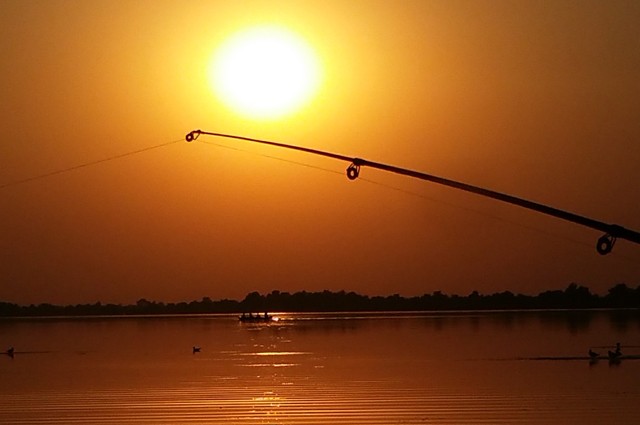
The fourth day was started for me at 5 am. Because together with another 2 passengers plus the captain we were going to fish pike. We started to go to Baclanesti Lake which was in the neighborhood. The fog was rising fast, and the low temperature was stimulating for our morning activities. We arrived and started to launch the bait in the water for pike. Launching, recovering and launching again, and again, and again...catching water plants, or nothing, until the moment when recovering the bait I felt the jolt of the caught pike. I brought it slowly to the boat, being careful to not take it out from the water because it would start to jump and escape from the hook. When it was close enough we took the net and take it out from the water. In the next hour, everyone catches another 2 pikes and we came back to the floating hotel right on time for breakfast. Of course, we made pictures with the prey, and then after breakfast, we were going to explore other parts of the Delta.
First of all, we took the way through Sontea Channel. Sontea Veche, Sontea Noua, and Sontea Lata channels are year-round navigable (for mid-sized boats) in lengths of 43.52 km, rivaling the length of the Litcov Canal, considered to be the longest channel in the Danube Delta.
The Sontea Canal is very long and consists of Garla Sontea Veche and Garla Sontea Lata, also known as the West Delta along its entire length, starting from the Sireasa Channel to the west and ending on the Grand “M” Loop at Mila 23 to the east and it is normal to have plenty of good fishing. I do not think there is a delta fisherman who does not have a place, good, and secret on this channel.
You can fish from the boat, but also from the shore. It can be reached both on a navigable way, but in some places like ours (near the confluence with the Mila 35 channel). The easiest entrance to this channel coming from Tulcea is: the Mila 35 channel (immediately to the left by the high voltage pylons on the Tulcea branch) then the right on the Sontea Noua canal, to a great extent parallel to Garla Sontea Veche, lies to the north of it also secured connection with the Stipoc Channel and through it, with the Chilia Arm. As fish species: all.
Fishing parties are always successful in this area, you can have record catches and you will always be pleased with what you will encounter in these unique places.
The Sontea Canal has a considerable width being the most important channel of the Western Delta, Sontea is used by both tourists and professional fishermen fishing in the lakes and jays of the West Delta, which do not allow you to sneak through the branches of the and the landscape is so minute that you almost lose the notion of time when you sail over the waters.
From here going to Lacul Nebunu. Lake Nebunu and its surroundings is a small stretch of the lake area, characteristic of the river delta that hosts specific biocoenoses, adapted to the large amplitudes of the flood wave. Nebunu Lake is located in the Sontea - Fortuna Lake Complex, a protected area. It covers an area of 115 hectares.
The reason why it was placed under the protection regime is that it provides optimum reproductive conditions for the fish species characteristic of such low-intensity lakes and with low depth and also ensures nesting conditions during the summer months for different species of ducks, egrets, swans, cormorants, and other water birds, but also mammals in the region.
Among the branches of the abysses, there are colonies made up of a bunch of nests of different bird species such as hawthorn, bumblebee, big egret, small egret, small cormorants, nests built among willow branches.
The lake is invaded by submerged and floating vegetation.
Here you can film and photograph the diversity of birds and landscapes around the lake, a wild paradise where the sun and weather have other dimensions.
From here follow Canal Sireasa to Canal 36. The Sireasa Canal starts from the northern third of the great 36 Mila Canal and ends west on the bank of the dyke that supports the DJ222N. The general direction of the Sireasa Canal is from E to V, but the canal presents several broad meanders along the way. In the first third (the one from Mila 36 Channel), the Sireasa Channel presents two perfectly parallel arms (the southern branch and the northern branch).
The entrance to Mila 36 Channel is on the first branch (the southern one), but both branches are perfectly accessible. On large water there are possibilities of crossing the southern to the northern arm, crossing a flood of forest flooded a few meters. Throughout its course, the Sireasa Canal has a broad look, with the firm, but bushy shores, wooded in the first half and poplar on the northern shore in the second half.
The Sireasa Canal can be fully moved in sliding, except for the critical points in the last Western Patriot. Beginning with the middle of the canal, the northern shore is tall enough to allow camping even on large water.
On this channel, you can fish at red, bayonet, perch, cormorant, sleep, pike, and caraway. Arriving on Canal 36.
Channel 36, a fishing spot very well known to Danube Delta fishermen. Maybe also because it is close to Tulcea, so it is quite accessible. The channel has an average width of about 15 meters and a length of 11 km and connects the Tulcea and Chilia arms.
The channel entry is from the Sulina arm, on the left-hand side between miles 35 and 36 immediately after the high-voltage pylons. There are many fishing spots, especially on the right side of the canal, not reed, the banks being accessible. The channel is heavily circulating because it connects with the Chilia arm, as we have already said, but also with the Channel Suna and Sireasca Channel.
Access is made by waterway if you want to fish.
On Channel 36, it flies especially to sleep, carp, and caraway, the main species targeted. However, we can not rule out the saddle, avatars, and pockets.
On channel 36 will stop for the night to sleep being prepared for the next day to come back to Tulcea



Leaving the Danube Delta
The fifth day is at the same time, the last day in the Danube Delta.
The boat will bring us back to Tulcea and will see again the city which represents the gate of the Danube Delta.
This last night in the middle of the wild has something magic. We can`t believe that our beautiful journey is almost ended.
After so many days in the delta we want to stay more we don`t wanna go home yet, but everything goes to an end, and also is our trip.
A beautiful journey in the middle of nature will never forget and promise to come back someday.

